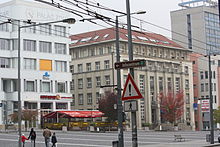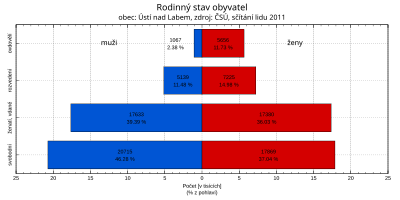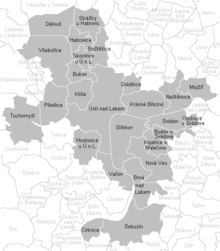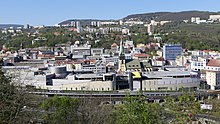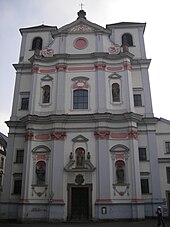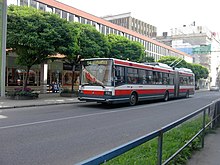Ústí nad Labem
| Ústí nad Labem | ||||
|---|---|---|---|---|
|
||||
| Basic data | ||||
| State : |
|
|||
| Historical part of the country : | Bohemia | |||
| Region : | Ústecký kraj | |||
| District : | Ústí nad Labem | |||
| Area : | 9396.9509 ha | |||
| Geographic location : | 50 ° 40 ' N , 14 ° 3' E | |||
| Height: | 218 m nm | |||
| Residents : | 92,952 (Jan 1, 2019) | |||
| Postal code : | 400 01 | |||
| License plate : | U | |||
| structure | ||||
| Status: | Statutory city | |||
| Districts: | 4 districts 22 districts |
|||
| administration | ||||
| Lord Mayor : | Petr Nedvědický (as of 2020) | |||
| Address: | Velká Hradební 8 401 00 Ústí nad Labem |
|||
| Municipality number: | 554804 | |||
| Website : | www.usti-nl.cz | |||
| Location of Ústí nad Labem in the Ústí nad Labem district | ||||
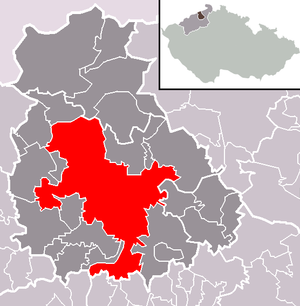
|
||||
Usti nad Labem ([ Usti nadˌlabɛm ] ; German Aussig , formerly Außig ) is a city on the Elbe in northern Bohemia . It is the center of the North Bohemian industrial and metropolitan area and the transport hub in the region.
Geographical location
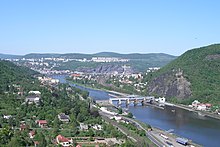
The city is located about 48 km south-southeast of Dresden at an altitude of 140 m above sea level. The old town of Aussig is located on the left bank of the Elbe at the mouth of the river Bílina (German: Biela ), 14 ° 2 ′ 30 ″ east longitude and 50 ° 39 ′ 33 ″ north latitude. In the north is the foothills of the Ore Mountains and to the south the Bohemian Central Mountains extend .
history
Origin of name
The name of the city was probably derived from the old Czech word ustie (ústí), which means confluence, whereby the mouth of the Biela (Czech Bílina ) into the Elbe should be meant. The city's Latin name was Usk super Albium .
middle Ages
In 993 the settlement was mentioned as a trading center on the Elbe. Přemysl Otakar II raised the place to a royal town in the first half of the 13th century . The rights were confirmed and expanded by the kings John of Luxembourg and Charles IV. The city was administered according to Magdeburg law .
During the Hussite Wars , the city belonged to the Margraves of Meissen and was besieged by the Hussites . The fighting reached its peak in 1426 on Na Běhání hill . The Germans lost the fight. After the city was conquered on June 16 in the battle of Aussig , the victorious Hussites under Andreas Prokop massacred the German residents of the city and destroyed Aussig. Then Jakoubek ruled from Vřesovice . The chronicles describe that the winners continued to live peacefully with the German population.
The 16th and 17th centuries saw a great boom. The city did not take part in the uprising against Ferdinand I in 1547 and was able to develop economically as a result. In the second half of the 16th century, more Germans moved in, who soon made up more than half of the population.
17th and 18th centuries
The Thirty Years' War had a catastrophic effect . The city has been looted and fined seven times. The aftermath lasted nearly two hundred years. At that time the city was meaningless and had less than 2000 inhabitants.
19th century
In 1813 the Battle of Kulm took place northwest of the city . After 1830, industrialization brought about a new increase in population.
The strong industrial growth and the expansion of river traffic resulted in numerous changes. After centuries of stagnation , houses were built again at the beginning of the 19th century. The medieval and renaissance houses as well as the city wall were removed. In addition to agriculture and viticulture, weaving mills, paint manufacturers and paper mills settled here. Almost sixty mines were opened in the area. Thanks to the coal deposits discovered in 1827 , the railway connection to Prague opened in 1850 and its continuation to Dresden (1851), Aussig became an industrial city. For barges, the Elbe was only navigable downstream from Aussig; This made Aussig an important port of transshipment between ship transport and land routes in Bohemia . In 1860 there were 7,950 inhabitants, four times as many as in 1840. Despite cholera , typhus and other epidemics , the population doubled over the next twenty years. The Bürgerliche Bräuhaus Aussig was built in 1867, today's Zlatopramen brewery. The first bridge over the Elbe was built in 1872. Since 1880, the soap factory moved Georg layer to Usti.
20th century
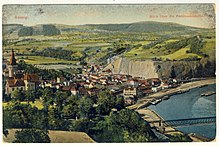
At the beginning of the 20th century, over 37,000 inhabitants lived in Aussig, which had developed into one of the most important industrial locations in Bohemia; Around 1900 about 2,600 workers were employed in the large chemicals factory alone. The city was the seat of a district court ( judicial district Aussig ) and a district commission ( district Aussig ). In addition, the superintendent of West Bohemia held office here from 1900 to 1918 , who presided over all German Lutherans in Bohemia. The Aussiger Anzeiger , which had existed since 1857, ceased its publication in 1919.
By 1935, many residents of the surrounding area had moved to the city, especially Germans. Konrad Henlein gave a speech here and achieved an absolute majority in the parliamentary elections.
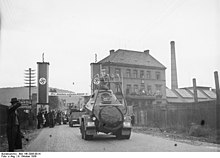
By the Munich Agreement , the city was awarded to the German Reich on October 9, 1938, together with the Sudetenland .
In the November pogrom of 1938, the Aussig synagogue was burned down. Of the town's 1200 or so Jewish population , about 80% fell victim to the National Socialist genocide .
On May 1, 1939, the communities of Hottowies, Pokau, Prödlitz, Schreckenstein, Türmitz and Ziebernik were incorporated into the city; At the same time, Aussig left the district of the same name and from then on formed its own urban district . In Aussig one of the three regional presidents in the Reichsgau Sudetenland , Hans Krebs , had his seat ( administrative district Aussig ).
Aussig was the headquarters of the Aussiger Verein , a major chemical, metallurgy and mining group, whose plants in Aussig and Falkenau at the time of National Socialism in the course of the " Aryanization " of IG Farben and the chemical factory v. Heyden were acquired together.
In 1945 the city of Aussig was part of the Aussig administrative district in the Reichsgau Sudetenland of the German Empire .
In addition to long-time residents, almost 60,000 Germans and around 3,000 Czechs, at the end of the war there were numerous prisoners of war, forced laborers from Poland, the Soviet Union and the Protectorate of Bohemia and Moravia, bombed out from West German cities and several thousand refugees from the war zones in Silesia. The tenants in Aussig were assigned two to three families to be quartered. In air raids by the USAAF on April 17 and 19, 1945, one fifth of the old town was destroyed, while the suburb of Oster (Ostrov) was completely destroyed. The number of victims was usually given as 1000 to 2500, but only the remains of 513 people have been found. 409 dead were identified, 324 of them locals and 46 Silesians, the rest from abroad.
Social democrats in the vicinity of the pre-war mayor Leopold Pölzl , who died on September 1, 1944, prevented the two Elbe bridges and the Elbe barrage in Schreckenstein from being blown up on May 7. In competition with the Social Democrats, the Czechs and some Germans founded a national committee in Aussig on May 7, 1945, to which the town's German police made themselves available on May 8 at 3 a.m. Shortly afterwards, Mayor Franz Czermak handed over the administration of the city, including medium-wave transmitters, to the National Committee. The city commandant and the head of the railway administration followed this example. The NSDAP district leader Rudolf Schittenhelm shot his family and himself on Mount Horka near Kulm . The first Soviet tanks passed through the city on May 8, but the Soviet army did not establish itself in the city until May 9. On May 9, there were fatalities in firefights between fleeing SS units and Soviet troops.
post war period
On July 31, 1945, after an explosion in an ammunition depot in the Schönpriesen district, a planned pogrom against the German civilian population took place. According to German data, between 1000 and 2700 people fell victim to the Aussig massacre , a maximum of 220 according to more recent sources, and between 40 and 100 people according to Czech data. The symbol of this massacre is the Elbe bridge between the old town and the Schreckenstein district.
With the aim of "ethnic unbundling" about 53,000 German were from the city from 1945 to 1946 sold . This happened in two phases, from the end of the war to the end of July 1945 through wild expulsion (odsun) and flight, and from January to December 1946 through an organized forced resettlement. The Germans were replaced by Czechs, who moved in both from the interior and as repatriates from abroad, as well as Slovaks and Roma , some of whom came from Romania and the Soviet Union . A cultural and historical tradition broke off in the region. In the 1970s and 1980s, the cityscape was permanently changed through the construction of traffic routes, large companies and prefabricated buildings .
Since the Jan Evangelista Purkyně University was founded in 1991, Ústí nad Labem has been a university town with around 7500 students. In 1998, Ústí hit the international headlines when the city began to build a wall around a district mainly inhabited by Roma. As a result, the suitability of the Czech Republic as a member of the European Union was temporarily questioned (see also Roma in the Czech Republic and Slovakia ).
Demographics
| year | Residents | Remarks |
|---|---|---|
| 1830 | 1,759 | in 321 houses |
| 1838 | 2,081 | in 341 houses |
| 1852 | approx. 2,600 | |
| 1900 | 37,265 | mostly German residents |
| 1930 | 71,256 | according to other data 43,793 inhabitants, of which 8,735 Czechs |
| 1939 | 66,975 | including 7,557 Protestants, 53,158 Catholics, 221 other Christians and 137 Jews |
- Population numbers after the end of the Second World War
| year | 1947 | 1978 | 2001 | 2004 | 2010 | 2014 | 2015 |
|---|---|---|---|---|---|---|---|
| Residents | 56,326 May 22, 1947 |
88,000 | 95,436 March 1, 2001 |
93,859 | 95,477 January 1, 2010 |
93 523 January 1, 2014 |
93,409 January 1, 2015 |
The following graphs show the structure of the inhabitants of the municipality of Ústí nad Labem in 2011 (blue = male, red = female):
City structure
City districts, districts, settlement units
Ústí nad Labem consists of four city districts, 22 districts and 96 basic settlement units:
|
|
Basic settlement units are Božtěšice, Brná, Brná-Čertova jizba (Devil's Chamber ) , Budov (Budowe) , Bukov-střed, Církvice, Dobětice (Doppitz) , Dukelských hrdinů, Habrovice, Hlavamenní nádrauší (Kamitz-Tillisch) , Ke Skřivánku, Klíše, Klíše-průmyslový obvod, Klíše-sportovní Areal, Klíše-školský Areal, Klíše-Vilová, Klíšská-Solvayova, Kočkov (Gatschken) , Kojetice, Kramoly (Krammel) , Krásné Březno, Krásné Březno-Novy Svet, Krásné Březno pod vyhlídkou, Krásné Březno-průmyslový obvod, Krásné Březno-Přístavní, Krásné Březno-západ, Malátova, Mariánský vrch-Hůrka (Marie Berg) , Masarykova nemocnice, stadiony Městské, Mojžíř, Na Dolech, Na Nivách I, Na Nivách II, Nad Brnu, Nad Březnem, Nad zoologickou záhradou, Neštěmice, Neštěmice-halda, Neštěmice-východ, Neštěmická, Nova Ves (Neudorfl) , Novosedlice (Obersedlitz) , Obchodní zóna Všebořice, Olešnice, Olšinky (Wolf loop) , Ovčárna, Ovčí vrch, Pod Střížovickým vrchem, Podhoří (German Neud örfel) , Pražská ulice, Předlice, Předlice-průmyslový obvod, Sady Bedřicha Smetany, Sebuzín, Severní Terasa, Severní Terasa-sever, Sídliště Dobětice, Sídliště Dobětice-západ, Sídliště Stone Hill, Sídliště Pod Holoměří, Sídliště Skalka, Sídliště Stříbrníky, Skorotice , Skřivánek (Lerchenfeld) , Strážky, Střekov-Kamenný vrch, Střekov-Karla IV, Střekov-lázně, Střekov-nábřeží, Střekov-nad hradem, Střekov-průmysríchý vrž, Střkov-průmysrízý vrž, Střchížový váří obvod, Stříchický víčovický III Tuchomyšl (Schonfeld) , U Bíliny, U polikliniky, stadionu U, Univerzitní kampus, Usti nad Labem-průmyslový obvod, Usti nad Labem-sever, Usti nad Labem-u západního nádraží, V Oblouku-Vojanova, Vaňov (Wanow) , Vaňov- Skály, Veselí (Wesseln) , Větruše (Ferdinandshöhe) , Všebořice (Schöbritz) , Všebořice-u vozovny, Západní nádraží and Žižkova. The locations Kolibov (Kolleben) , Průčelí (Prutschl) , Roudné (Raudney) , Sedlo (Sedl) , Stříbrníky (Ziebernik) and Úžín (Auschina) also belong to Ústí nad Labem .
coat of arms
Description : In red, an armored, silver, gold- armored, double - tailed lion with a pierced helmet and a golden flight on top .
Cadastre
The urban area is divided into the 26 cadastral districts of Božtěšice, Brná nad Labem, Budov u Svádova, Bukov, Církvice, Dělouš, Dobětice, Habrovice, Hostovice u Ústí nad Labem, Klíše, Kojetice u Malečřice, Nejátřízov, Krásné Březov Olešnice u Svádova, Předlice, Sebuzín, Skorotice u Ústí nad Labem, Strážky u Habrovic, Střekov, Svádov, Tuchomyšl, Ústí nad Labem, Vaňov and Všebořice.
Culture and sights
Theaters and museums
The city has three professional theater ensembles ( ballet , opera , theater ), seven choirs, a chamber orchestra and other cultural associations. There are also some dance groups working here. Several national and international events are held annually (theater festival of private middle schools, competition of young pianists “Virtuosi Per Musica Di Pianoforte”, “International Festival of Choral Singing”, Country and Western Festival “Trampská Porta” and above all the “Internationale Dance Festival ").
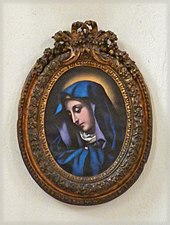
The city museum mainly includes the natural science collections on nature in north-west Bohemia, the Central Bohemian Uplands and the Ore Mountains.
In Ústí there has been a museum on the history and culture of the German-speaking inhabitants of the Bohemian lands run by the Collegium Bohemicum since about 2011, which aims to maintain the cultural legacy of the German-speaking population in Bohemia who were expelled after 1945.
Buildings
- Deanery Church of the Assumption
- The original Church of the Assumption of the Blessed Virgin Mary was built in 1318, but fell victim to the Hussite Wars . The successor building was built after 1452 and was rebuilt in the late Gothic style in the 1880s . The current inclined position of the tower caused an air raid in April 1945, during which the tower fell 1.92 m from its vertical axis, which, according to the signs, became the “most leaning tower north of the Alps”; however, the leaning tower of Suurhusen is even more inclined. In the church is the Aussiger Madonna by Ismael Mengs , a copy of the Mater dolorosa (Madonna Addolorata) by Carlo Dolci , from which Richard Wagner, according to a letter from 1842, was inspired to design St. Elisabeth in Tannhäuser .
- St. Adalbert Church
- The baroque Dominican monastery church built by Octavio Broggio between 1715 and 1730 replaced an 11th century church. The second largest organ in the Czech Republic is located in the Adalbertkirche .
- City Theatre
- The neo-baroque theater was built in 1908/09 according to designs by the Viennese architect Alexander Graf and furnished with paintings by Eduard Veith .
- city Museum
- The museum, founded in 1876, is one of the oldest of its kind in Northern Bohemia. The collection was housed in Trmice Castle from 1919 to 1994 . Since 1995 it has found its place in a former school building next to the city theater. The exhibition is mainly dedicated to the town and military history as well as the natural areas of the Eastern Ore Mountains and the Bohemian Central Mountains .

- Střekov castle ruins
- The ruins of the Střekov castle, built in the early 14th century, rise high above the right bank of the Elbe. It has been owned by the Lobkowitz family since 1564 . However, due to damage in the Thirty Years 'War and the Seven Years' War , the facility fell into disrepair. The adjoining courtyard with brewery was preserved and is still in use today. Richard Wagner was inspired by Střekov for his opera Tannhäuser .
- The castle in Velké Březno (Großpriesen) , which rises steeply on a ridge above the Elbe , was built on behalf of Count Karel Chotek between 1842 and 1845. This building currently houses an exhibition about the Chotek family.
- Větruše
- Větruše, the dominant building, stands on a rock above the Elbe. It was built in 1847 as a restaurant under the name Ferdinandshöhe. The stately building is now a restaurant again. A cable car has been running from an inner-city shopping center directly up to the restaurant since December 7, 2010.
- Bridges in Ústí
- In the immediate city of Aussiger there are four bridges, three of them over the Elbe, the other over the Bílina . This is also the oldest in the city. The Beneš Bridge, built in 1934, is named after Edvard Beneš, who was in office between 1945 and 1948 . The original railway bridge was built between 1872 and 1874. After severe destruction, it was rebuilt in 1945. In 1998 the newest bridge was built, the Mariánský most (Marienbrücke). It is carried by ropes that are attached to pillars on the right bank of the Elbe.
Green spaces and recreation
The zoological garden houses around 1500 animals, which are distributed in more than 250 different species.
Sports
In the 2007/08 season, HC Slovan Ústečtí Lvi played in the top Czech league in ice hockey , the Extraliga . The home games are played in the Zlatopramen Arena , which was built in 1965 and renovated in 2004 .
The football club FK Ústí nad Labem managed to rise to the first division in the 2010 season . The home games had to be played in Teplice due to the lack of a suitable stadium. After relegation in 2011, the team achieved renewed promotion in 2012, but received no license for the top division due to the stadium problem.
Regular events
The Ústí half marathon has been held in September since 2011 .
Economy and Infrastructure
Industry
In 1841 the Johann Maresch manufactory was founded (first as Bähr & Maresch , later Johann Maresch Thon- und Steingutwaren fabric in Aussig ). In addition to household goods, figures were made from clay. The best known are probably the garden gnomes and garden figures by Maresch. After 1945 the company was closed.
The Georg layer AG belonged before the First World War to the big companies in the Austrian soap, and candles Fette area. The joint stock company for chemical and metallurgical production called the Aussiger Verein was also essential .
Heavy industry was built up during the communist regime. Chemical and food factories and glassworks are right in the center of the city. The most important employer in Ústí is "Spolchemie", which today also produces the finest special raw materials in addition to heavy chemicals. In the west, in Trmice, there is a power station with heat generation. The high level of air and water pollution is decreasing more and more. The environmental requirements of the Czech state are meanwhile higher than comparable ones in the Federal Republic of Germany. Great efforts are still being made to reduce environmental pollution, which has also been awarded by the EU . The Elbe port is important for inland shipping.
traffic
city traffic
In 2016, the municipal transport company ( DPmÚL ) maintained 11 trolleybus routes , 16 bus routes and a cable car during the day . Two trolleybus and two bus lines operate at night. From 1899 to 1970 there was a tram network of eight lines with a total length of 34 km, of which 10.4 km were double-track, which was the third longest in Czechoslovakia after Prague and Brno.
Long-distance transport
Ústí nad Labem is located on the Pan-European Transport Corridor IV (Berlin - Prague - Vienna / Bratislava - Budapest - Constanta / Thessaloniki).
railroad
Ústí is an important railway junction. The Prague – Děčín railway is part of the international connection from Berlin to Vienna. The double- track Ústí nad Labem – Chomutov railway leads to the west and continues via Cheb to Nuremberg . The Kolín – Děčín railway runs to the right of the Elbe and serves as a freight line through the Czech Republic. ČD Cargo operates an important base (SOKV) for the maintenance of locomotives and wagons.
Trunk roads
The city is connected to the international road E 442 ( Liberec , Děčín , Teplice, Karlovy Vary) and the first class roads (I / 8, I / 30, I / 13). It is also directly connected to the D8 motorway (Dresden - Prague, E 55, A 17 ), which runs through the west of the city; the remaining sections were opened to traffic in 2006.
Waterways
The Elbe waterway (Labská) is a connecting route to the network of Western European waterways with access to Germany , France , Benelux and major seaports . Both freight and passenger traffic exist on the Pardubice - Chvaletice - Ústí nad Labem - Hamburg route . Around 1910, the Aussig Elbe port had the second-highest throughput in the Austro-Hungarian Empire after the Adriatic port of Trieste, at 1.5 million tons per year.
Air traffic
The nearest international airports are in Prague-Ruzyně and Dresden .
Personalities
Town twinning
Ústí nad Labem maintains the following cities partnerships :
literature
- Friedrich Sonnewend: History of the royal free city of Aussig . CW Medau, Prague, Leitmeritz and Teplitz 1844 ( e-copy )
- Franz Josef Umlauft: History of the German city of Aussig , Ellwanger, Bayreuth 1960 (reprint: Munich 1983)
- Eduard Wagner: Aussig. A home book. Volume 1: Pictures from the historical development of the city. Ad. Beckers Buchhandlung, Aussig 1923 (Reprint. Aufstieg-Verlag, Munich 1973, ISBN 3-7612-0109-5 ).
Web links
- Heimatfreunde Aussig
- Architecture in Ústí nad Labem
- History of the city of Ústí nad Labem
- digital editions of the Aussiger Boten from 1948
Individual evidence
- ↑ uir.cz
- ↑ Český statistický úřad - The population of the Czech municipalities as of January 1, 2019 (PDF; 7.4 MiB)
- ^ Heinrich Gottfried Gengler : Codex Juris Municipalis Germaniae Medii Aevi. Regesta and documents on the constitutional and legal history of German cities in the Middle Ages. Volume 1. Enke, Erlangen 1863, p. 93 ( books.google.de ).
- ↑ a b Meyer's Large Conversation Lexicon . 6th edition, Volume 2, Leipzig and Vienna 1905, p. 153.
- ↑ Martina Schneibergová: On the history of the Jewish community in Usti nad Labem / Aussig , on Radio Prague , October 22, 2005
- ↑ a b Vladimír Kaiser: The end of the war and the expulsion of the Germans from the Aussiger area. In: Detlef Brandes, Edita Ivaničková, Jiří Pešek (eds.): Forced separation. Expulsions and resettlements in and from Czechoslovakia 1938–1947 in comparison with Poland, Hungary and Yugoslavia (= publications by the German-Czech and German-Slovak historians' commission. Volume 8. = publications by the Institute for the Culture and History of Germans in Eastern Europe. Volume 15). Klartext, Essen 1999, ISBN 3-88474-803-3 , pp. 197-214.
- ^ Peter Steinkamp: Aussig 1945. In: Gerd R. Ueberschär (Ed.): Places of horror. Crimes in World War II. Darmstadt 2003. Darmstadt 2003, p. Here p. 16 .
- ↑ Thomas Schmid: The Forgotten. A brave social democrat in the Sudetenland. welt.de, August 3, 2015, accessed April 4, 2016 .
- ↑ Yearbooks of the Bohemian Museum of Natural and Regional Studies, History, Art and Literature . Volume 2, Prague 1831, p. 197, point 2).
- ^ Friedrich Sonnewend: History of the royal free city of Aussig . CW Medau, Prague, Leitmeritz and Teplitz 1844, p. 224.
- ↑ Topographic Lexicon of Bohemia . Prague 1852, p. 10.
- ^ A b Michael Rademacher: German administrative history from the unification of the Reich in 1871 to the reunification in 1990. sud_aussig.html. (Online material for the dissertation, Osnabrück 2006).
- ↑ Information from the Czech Statistical Office for 2010, online at: czso.cz , accessed on December 29, 2010.
- ↑ Information from the Czech Statistical Office for January 1, 2015, online at: czso.cz (PDF), accessed on September 14, 2015.
- ↑ uir.cz
- ↑ uir.cz
- ↑ uir.cz
- ↑ uir.cz
- ^ Letter to Ernst Benedikt Kietz from June 6th to 10th. September 1842: Richard Wagner: Complete Letters. Volume 2: Letters from 1842–1849. Published by Gertrud Strobel and Werner Wolf on behalf of the Richard Wagner Family Archive Bayreuth . Deutscher Verlag für Musik, Leipzig 1970, p. 153; see. Dieter Borchmeyer : Richard Wagner. Ahasver's changes. Insel-Verlag, Frankfurt am Main et al. 2002, ISBN 3-458-17135-5 , p. 156.
- ^ The World of Johann Maresch , online at; home.earthlink.net / ...
- ↑ The Maresch family from the town of Aussig an der Elbe , online at: www.heimatfreunde-aussig.de/
- ↑ Vladimir: Sister Cities
- ↑ Ústí nad Labem (Czech Republic). (No longer available online.) Archived from the original on December 28, 2017 ; accessed on December 28, 2017 . Info: The archive link was inserted automatically and has not yet been checked. Please check the original and archive link according to the instructions and then remove this notice.



